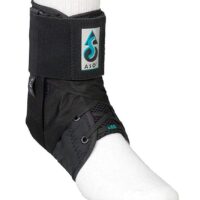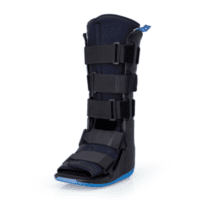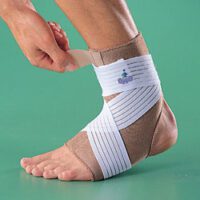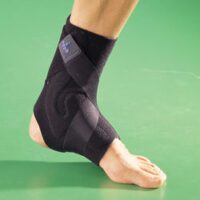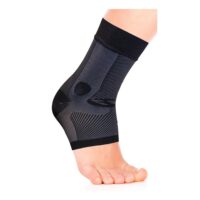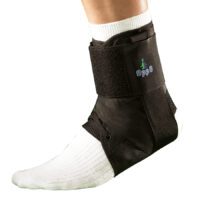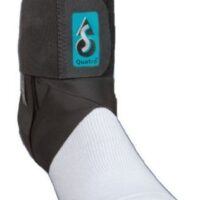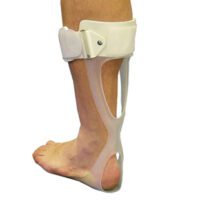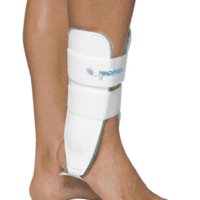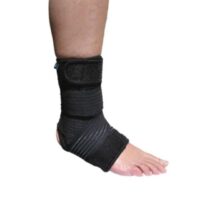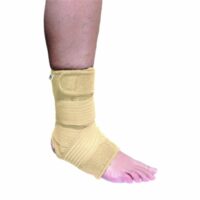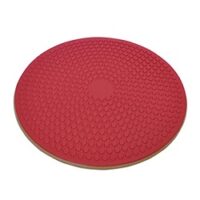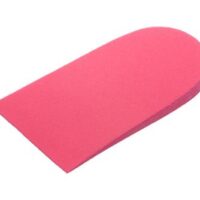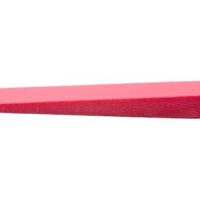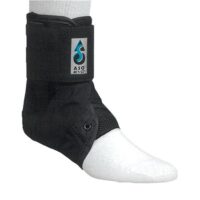High Ankle Sprain
Article by John Miller

High Ankle Sprains
What are High Ankle Sprains?
High ankle sprains, injuries to the upper ankle ligaments above the ankle joint, often involve the syndesmosis, the fibrous connection between the tibia and fibula. These sprains differ from lower ankle sprains in severity and treatment. Early diagnosis by a physiotherapist or foot doctor is crucial.
The Nature of High Ankle Sprains
High ankle sprains, or syndesmotic injuries, present challenges due to their lack of passive ankle stability in weight-bearing, leading to long-term functional instability. The differentiation between stable and unstable high ankle injuries is critical. Stable sprains may be treated conservatively, while unstable ones often require surgery.
Causes of High Ankle Sprains
These injuries typically occur when the foot is planted and twisted outwards excessively, or when the ankle is heavily loaded and pushed into extreme dorsiflexion, common in football tackles.
Identifying Symptoms
Symptoms include pain above the ankle, especially with outward foot rotation, difficulty in walking, bruising, swelling, and inability to perform single-leg calf raises. The severity of symptoms varies with the sprain grade.
Differentiating High Ankle Sprain and Syndesmosis Injury
High Ankle Sprain
A high ankle sprain affects the ligaments connecting the tibia and fibula above the ankle. It usually results from forceful outward twisting of the foot and ankle.
Syndesmosis Injury
This broader term refers to damage to the entire syndesmosis joint, potentially including ligaments. It arises from similar mechanisms as a high ankle sprain but can encompass more trauma types.
Diagnosis and Treatment
Diagnosing High Ankle Sprains
Physiotherapists, sports doctors, or ankle surgeons assess ligament integrity and may recommend imaging tests to confirm a diagnosis. A gap greater than 2mm in the inferior tibiofibular joint indicates potential instability.
Treatment Approaches
Treatment aims to restore stability between the tibia and fibula. Physiotherapy is crucial, whether the injury is stable or requires surgery. Treatment goals include pain relief, inflammation control, regaining motion range, strengthening muscles, restoring joint proprioception and balance, and returning to normal function.

Physiotherapy Treatment Phases
Phase 1: Injury Protection and Pain Relief
Initial treatment includes RICE (Rest, Ice, Compression, Elevation), with active rest crucial. Compression bandages and elevation aid in reducing swelling, while physiotherapists may employ various techniques for pain relief. A moon boot is normally prescribed to provide support for the healing ligaments.
Phase 2: Regaining Full Range of Motion
Targeting joint range of motion, muscle length, and neural tissue motion is essential, avoiding overstretching ligaments.
Phase 3: Restoring Muscle Strength
Strengthening exercises, progressing from non-weight-bearing to full-weight-bearing, are key for dynamic ankle control.
Phase 4: Normalising Foot Biomechanics
Foot arch assessment may lead to using orthotics or specific foot stabilisation programs.
Phase 5: Restoring High-Speed, Power, Proprioception, and Agility
Addressing balance and proprioception minimises re-injury risks and prepares for sport-specific activities.

Phase 6: Return to Sport
A customised training regimen ensures a safe return to sport, focusing on speed, power, agility, and function.
Recovery and Long-Term Considerations
Recovery Timeline
Recovery times vary with injury severity, from six weeks for mild sprains to several months for severe injuries. Professional rehabilitation ensures proper healing and function restoration.
Risks of Untreated Sprains
Neglecting treatment can lead to joint stiffness, ligament laxity, muscle weakness, and increased arthritis risk. Chronic ankle sprains require more complex treatment due to established complications.
The Importance of Professional Care
High ankle sprains, if misdiagnosed or untreated, can lead to significant joint destruction, necessitating surgery. Early and appropriate intervention is essential.
Conclusion: The Role of Physiotherapy
Physiotherapy plays a pivotal role in diagnosing, treating, and rehabilitating high ankle sprains and syndesmosis injuries. Professional guidance ensures accurate assessment and tailored treatment plans, minimising long-term complications and facilitating optimal recovery.
Remember, if you suspect a high ankle sprain or syndesmosis injury, consult your physiotherapist or healthcare specialist for precise diagnosis and effective treatment. Early and professional intervention is key to a successful recovery and return to normal activity.
Common Causes of Ankle Pain
Introduction
Welcome to our detailed guide on the common causes of ankle pain. As physiotherapists, we understand how various conditions and injuries can lead to discomfort in your ankle. From sprains to degenerative diseases, this guide aims to provide clear insights for the general public on navigating these issues.
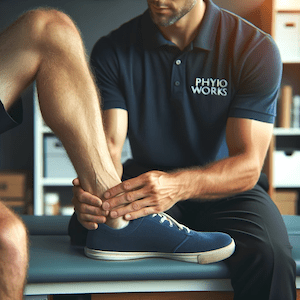

Sprained Ankles and Syndesmosis Injuries
Sprained ankles, including syndesmosis injuries, are among the most common issues we encounter. These injuries can range from mild ligament stretches to severe tears, impacting your mobility and quality of life. Understanding the specifics of each type is crucial for effective treatment and timely recovery.
Ankle Tendinopathies
Tendinopathies, such as those affecting the Achilles and tibialis posterior tendons, are common in active individuals. These conditions arise due to overuse or trauma, leading to pain and swelling in the affected area. Targeted physiotherapy can significantly aid in recovery and prevent future injuries.
Posterior Ankle Conditions
Conditions like posterior ankle impingement and retrocalcaneal bursitis can cause significant pain, especially during physical activities. Recognising these conditions early and starting appropriate treatment is vital for maintaining ankle health and functionality.
Ankle Arthritis
Arthritis in the ankle, often a result of wear and tear or injury, leads to joint pain and stiffness. Early intervention and proper management, including physiotherapy, are essential to slow its progression and manage symptoms effectively.
Biomechanical Conditions
Abnormal foot and ankle biomechanics can lead to various issues, from pain during weight-bearing to nerve compression. Understanding and treating these conditions are crucial for restoring normal function and preventing further complications.
Systemic Conditions That May Cause Ankle Pain
Systemic diseases such as rheumatoid arthritis can manifest as ankle pain. It's important to address these underlying conditions to effectively manage ankle symptoms.
Conclusion
Ankle pain can arise from a multitude of causes, each requiring a unique approach to treatment. If you're experiencing ankle discomfort, we recommend consulting a physiotherapist or doctor for a thorough evaluation. A personalised care plan can significantly improve your quality of life and mobility.
Related Articles
- Sprained Ankle Treatment & Recovery Guide - This article provides comprehensive information on managing pain and inflammation for a sprained ankle, including initial RICE steps and exercises for restoring mobility.
- Anterior Ankle Impingement: Causes, Treatments, Tips & Guide - Offers insights into the causes of anterior ankle impingement, its treatments, and practical tips for management.
- Posterior Ankle Impingement: Causes & Treatments - Explains the condition of posterior ankle impingement, its causes, and available treatment options.
- Tibialis Posterior Tendinopathy - Discusses the condition affecting the tibialis posterior tendon, symptoms, and implications for foot arch pain and ankle stability.
- Achilles Tendinopathy - Answers frequently asked questions about foot and ankle pain associated with Achilles tendinopathy and provides an overview of tendon injuries.
- How To Strap An Ankle - Guides on the correct techniques and types of tape for ankle strapping to prevent or manage ankle injuries.
Foot, Ankle & Heel Pain FAQs
Introduction
Welcome to PhysioWorks' comprehensive FAQ page on Foot, Ankle, and Heel Pain. Our expert physiotherapists are here to guide you in managing and overcoming discomfort. We’ve organised the FAQs into categories, each with a brief overview and links to in-depth articles, making navigation and understanding easier for you.


Foot Pain
Step into the various causes of foot pain and learn effective ways to relieve discomfort. Understand the impact of activities like barefoot running.
Ankle Injuries
Explore common ankle injuries and how to address them. From sprains to ligament damage, find out the best practices for care and prevention.
Heel Pain
Uncover the reasons behind heel pain and the effective treatments available. This section is particularly useful for understanding conditions like plantar fasciitis and heel spurs.
Achilles Pain
Find out how to manage and treat Achilles tendinopathy, a common concern for athletes and active individuals.
Shin Pain
Learn about shin splints, their causes, and how to alleviate this common issue, especially among runners.
Youth Injuries
Gain insights into youth leg injuries, including growing pains and heel issues in children.
Balance & Proprioception
Enhance your balance and proprioception with our professional advice and exercises.
Related Articles
- Sprained Ankle Treatment & Recovery Guide: Offers detailed advice on how to manage sprained ankles, including immediate recovery steps and physiotherapy treatments.
- Ankle Pain: Effective Management And Treatment Options: Discusses various conditions leading to ankle pain and outlines effective treatment strategies, highlighting the role of physiotherapy in pain reduction and mobility improvement.
- Plantar Fasciitis: Provides an overview of plantar fasciitis, including common causes, treatment options, and related conditions like peroneal tendinopathy and Achilles tendinopathy.
- Achilles Tendinopathy: Focuses on the causes of Achilles tendinopathy, its impact on heel pain, and a range of treatment and prevention strategies.
- Ankle Strapping: Complete Guide To Injury Prevention: Explains the benefits of ankle strapping as a preventative measure against injuries, with a focus on techniques and materials.
- Heel Pain: Explores various causes of heel pain, including tendon injuries, foot injuries, bone injuries, and systemic conditions, alongside recommended treatments.



